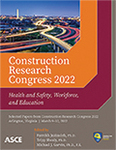Random Forest Analysis of Occupational Accident Reports among Roofing Contractors
Publication: Construction Research Congress 2022
ABSTRACT
One of the trades most susceptible to occupational hazards in the construction industry is roofing contractors, whose projects inherently involve exposure to falls from height. In response, this study used a random forest data mining technique to analyze the impacts of accidents’ contributing factors on roofers’ injuries. The analysis examined over 600 incidents obtained from the Occupational Safety and Health Administration’s (OSHA’s) database of fatal and nonfatal accident reports. Some of the contributing factors considered include source of injury, cause of injury, project cost, project end use, project type, injured body part, and day of injury. The results of validated random forest model revealed that the most important factor for predicting the nature of injury is injured body part followed by source of injury. The presented results can be used by managers, policymakers, and safety professionals to reduce the frequency and severity of incidents.
Get full access to this article
View all available purchase options and get full access to this chapter.
REFERENCES
Breiman, L. (2001). Random Forests. Machine Learning, 45(1), 5–32. https://doi.org/10.1023/A:1010933404324.
BLS (Bureau of Labor Statistics). (2006). Fatal occupational injuries by industry and event or exposure. <http://www.bls.gov/iif/oshcfoi1.htm>, (June 7, 2021).
BLS (Bureau of Labor Statistics). (2007). Roofers. <https://www.bls.gov/oco/ocos212.htm>(May 7, 2021).
BLS (Bureau of Labor Statistics). (2012). Occupational Injury and Illness Classification Manual (OIICM). <https://www.bls.gov/iif/oiics_manual_2010.pdf>, (March 5, 2019).
BLS (Bureau of Labor Statistics). (2018). Census of fatal occupational injuries. <https://www.bls.gov/news.release/pdf/cfoi.pdf>(April 18, 2021).
Choi, S. D., Griinke, D., and Lederer, M. (2006). Fall protection equipment effects on productivity and safety in residential roofing construction. Journal of Construction Research, 7:149–157.
CPWR - The Center for Construction Research and Training. (2013). Fatal and Nonfatal Injuries from Falls in Construction. The Construction Chart Book. <https://stopconstructionfalls.com/wp-content/uploads/2013/07/Fatal-and-Nonfatal-Injuries-from-Falls-in-Construction-2013-update.pdf.
Dong, X. S., Choi, S. D., Borchardt, J. G., Wang, X., and Largay, J. A. (2013). Fatal falls from roofs among U.S. construction workers. Journal of Safety Research 44, 17–24.
Fredericks, T. K., Abudayyeh, O., Choi, S. D., Wiersma, M., and Charles, M. (2005) Occupational Injuries and Fatalities in the Roofing Contracting Industry. Journal of Construction Engineering and Management, 131(11): 1233–1240.
Gholizadeh, P., Onuchukwu, I. S., and Esmaeili, B. (2021). Trends in Catastrophic Occupational Incidents among Electrical Contractors, 2007–2013. International Journal of Environmental Research and Public Health, 18(10), 5126.
Hinze, J., Huang, X., and McGlothlin, J. D. (2002). Review of fall accidents in construction. In Proceedings of the 10th International Symposium on Construction Innovation and Global Competitiveness (Eds.: B. Uwakweh and I. Minkarah). FL: Boca Raton, CRC press, 1117–1132.
Hung, Y. H., Winchester, W. W., III, Smith-Jackson, T. L., Kleiner, B. M., Babski-Reeves, K. L., and Mills, T. H., III. (2013). Identifying fall-protection training needs for residential roofing subcontractors. Applied Ergonomics, 44(3), 372–380.
Hung, Y. H., Winchester, W., Smith-Jackson, T., Mills, T., Kleiner, B., and Babski-Reeves, K. (2009). Fall Protection Training: Needs Analysis for Small Residential Roofing Subcontractors. Human Factors and Ergonomics Society Annual Meeting Proceedings 53(20), 1632–1636.
Izquierdo-Verdiguier, E., and Zurita-Milla, R. (2020). An evaluation of Guided Regularized Random Forest for classification and regression tasks in remote sensing. International Journal of Applied Earth Observation and Geoinformation, 88,1–13.
Kaskutas, V., Dale, A. M., Nolan, J., Patterson, D., Lipscomb, H. J., and Evanoff, B. (2009). Fall hazard control observed on residential construction sites. American Journal of Industrial Medicine, 52(6), 491–499.
Liaw, A., and Wiener, M. (2002). Classification and Regression by randomForest. R News, 2(3), 18–22.
Liu, X.-Y., Wu, J., and Zhou, Z. H. (2009). Exploratory undersampling for class-imbalance learning. IEEE transactions on systems, man, and cybernetics. Part B, Cybernetics : a publication of the IEEE Systems, Man, and Cybernetics Society, 39(2), 539–550.
McHugh, M. L. (2012). Interrater reliability: the kappa statistic. Biochemia Medica (Zagreb); 22(3):276–282. PMID: 23092060; PMCID: PMC3900052.
Mistikoglu, G., Gerek, I. H., Erdis, E., Usmen, P. E. M., Cakan, H., and Kazan, E. E. (2015). Decision tree analysis of construction fall accidents involving roofers. Expert Systems with Applications, 42, 2256–2263.
Moore, J. R., and Wanger, J. P. (2014). Fatal events in residential roofing. Safety Science, 70, 262–269.
OSHA (Occupational Safety and Health Administration). (2017). Worker Deaths in 2017. Commonly Used Statistics <https://www.osha.gov/oshstats/commonstats.html>.
Olbina, S., Hinze, J., and Ruben, M. (2011). Safety in roofing: Practices of contractors that employ Hispanic workers. Professional Safety, 56(4), 44–52.
R Core Team. (2013). R: A language and environment for statistical computing. R Foundation for Statistical Computing, Vienna, Austria. URL http://www.R-project.org/.
Sa, J., Seo, D. C., and Choi, S. D. (2009). Comparison of risk factors for falls from height between commercial and residential roofers. Journal of Safety Research, 40(1), 1–6.
Stern, F. B., Ruder, A. M., and Chen, M. D. (2000). Proportionate Mortality Among Unionized Roofers and Waterproofers. American Journal of Industrial Medicine, 37, 478–492.
Information & Authors
Information
Published In
History
Published online: Mar 7, 2022
Authors
Metrics & Citations
Metrics
Citations
Download citation
If you have the appropriate software installed, you can download article citation data to the citation manager of your choice. Simply select your manager software from the list below and click Download.
Cited by
- Ikechukwu Sylvester Onuchukwu, Behzad Esmaeili, Sébastien Hélie, Support Vector Machine Analysis of Construction Workers’ Automatic Behavior and Visual Attention, Construction Research Congress 2024, 10.1061/9780784485293.086, (865-874), (2024).
